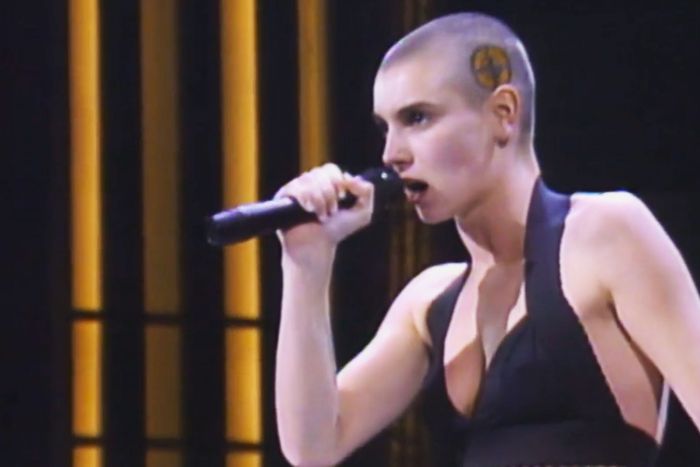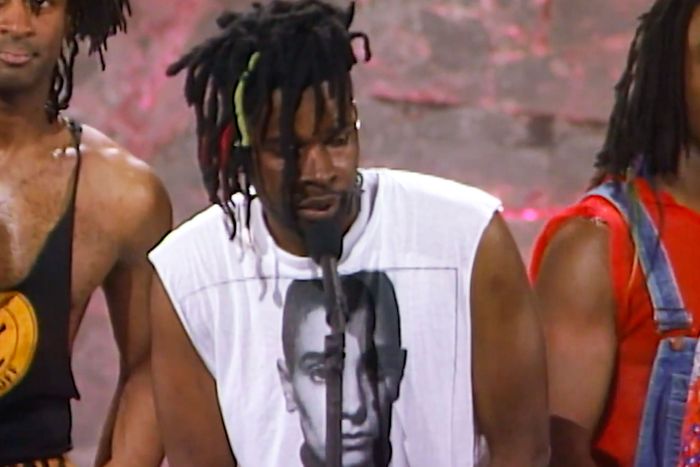
Sinead O’Connor has died at the age of 56. In light of her passing, we’re re-running this 2022 essay on the singer’s first Stateside performance.
February 22, 1989, the 31st annual Grammy Awards. Among the nominees for Best Rock Vocal Performance, Female are Tina Turner, Pat Benatar, Melissa Etheridge, Toni Childs, and Sinéad O’Connor. O’Connor has performed once on Late Night with David Letterman, but she has yet to appear on primetime American television. Tuxedo-clad host Billy Crystal introduces her to the tens of millions watching at home, explaining that O’Connor is a 21-year-old singer from Ireland and that “with her very first album, The Lion and the Cobra, she has served notice that this is no ordinary talent.”
Most people point to O’Connor’s destruction of a photo of Pope John Paul II, during her October 1992 performance on Saturday Night Live, as the reason for her exile from the pop world. But it was on this night in Los Angeles, three years prior, that revealed from the outset what the rest of the rest of the world would learn soon enough: her willingness to take a stand made her powerful — and threatening.
As the first few notes of O’Connor’s runaway college radio hit “Mandinka” kick in, the curtain rises on a darkened stage. She steps forward as if entering from a void, her hair shorn nearly to the scalp, her midriff exposed by a black halter top, her baggy, low-slung blue jeans ripped and torn. She touches her face almost like she can’t believe she’s there. O’Connor’s voice is clear and cutting, alternating between a whisper and a dare. If you look closely you might notice that she is wearing an infant’s sleepsuit tied behind her waist as she rocks back and forth in her Doc Martens, wailing, “I don’t know no shame/I feel no pain/I can’t see the flame!” Even from a distance, you can’t miss the massive man in the crosshairs of a gun that’s been painted onto the side of her shaved head, an arresting image even if you don’t immediately catch the reference.
After she was done, reporters from the L.A. Times described O’Connor as looking nervous backstage. Although they commended her performance, and her outfit, they quoted her remarking on what had just transpired, as though she were crashing the party. “I thought it was a little odd that they asked me to perform, because of the way I look,” she told them, “But I find it encouraging that they asked, because it’s an acknowledgment that they are prepared not to be so safe about the music and push forward with people slightly off the wall.”
If only that were true. ”Mandinka” was a fearless battle cry, but it was only her opening act. The onesie O’Connor wore was her son Jake’s, a middle finger to the executives at her record label who had warned her that motherhood and a career were incompatible. The man in the crosshairs was Public Enemy’s logo, which Chuck D described as symbolizing the Black man in America. She wore it as a badge of solidarity with the band, and by extension, all rappers who had been erased from the program. For years, the powerful white men who controlled the Recording Academy had dismissed rap as a passing fad or considered it dangerously subversive. Yet by 1989 the genre had become too popular to simply ignore. So they decided to confer the first-ever award for Best Rap Performance, but not to televise it. The trophy went to DJ Jazzy Jeff & The Fresh Prince for their G-rated pop crossover single “Parents Just Don’t Understand,” but they weren’t on hand that night, having led a boycott that also included fellow nominees Salt-N-Pepa and LL Cool J.
O’Connor was in fact no ordinary talent, and she had served notice, using music’s biggest night to put herself on the map and set the terms of her agenda. Despite not winning the Grammy, she subverted the record label’s hot-girl marketing strategy at a time when starlets like Tiffany and Debbie Gibson were burning up the pop charts. Despite the Recording Academy’s attempts to suppress rap, she managed to foil those plans too. O’Connor showed us a fierceness that made her great, but also foreshadowed how it would all come crashing down, sooner rather than later.
Kathryn Ferguson’s new documentary Nothing Compares, now in theaters and streaming on Showtime, traces that arc, starting with O’Connor’s early life in theocratic Ireland, where she suffered severe abuse at the hands of her devoutly religious mother, then became a rebellious teen who found her voice at a Catholic girls reformatory school. After signing her first recording contract at 18, and concluding that the producer assigned to mold her debut was zapping the life out of her songs, O’Connor took over the reins herself, pouring all of her intensity into The Lion and the Cobra. But her record company still tried to soften her appearance, switching out the photo on the album cover because the original would make her look too “angry” to American audiences.
Despite being decidedly anti-pop, her piercing musical memoir became a surprise commercial hit, ultimately going gold. O’Connor then topped that with her multi-platinum follow up, 1990’s I Do Not Want What I Haven’t Got. Thanks in large part to non-stop MTV airplay of the music video for the Prince-penned lead single “Nothing Compares 2 U,” O’Connor became a global celebrity, her expressive face a meme before memes. But as her star rose even higher, so did the scrutiny. When O’Connor withdrew from a 1990 appearance on SNL after learning that the comedian Andrew Dice Clay was scheduled to host, The Diceman, known for his misogynistic and homophobic routines, performed a skit poking fun at the “bald chick.” After O’Connor declined to have the national anthem played before a show at New Jersey’s Garden State Arts Center, Frank Sinatra said she must be “one stupid broad” and threatened to “kick her ass.”
Politicians organized protests against O’Connor. DJs refused to play her records. O’Connor was widely accused of censorship when it was she who was being censored. She was also criticized for being “anti-American” and ungrateful for the success she had achieved. Still, that fall she swept the MTV Video Music Awards with wins for Best Female Music Video and Best Post-Modern Music Video, and even bested Madonna for Video of the Year.
O’Connor seemed a little shocked. Aside from saying thanks when she was presented with the first two trophies, she said almost nothing. But with the third, she doubled down, using her speech to connect her experience with the industry’s censorship of Black artists. Explaining her reasons for not wanting the national anthem played before her shows, O’Connor told the global audience, “It’s the American system I have disrespect for, which imposes censorship on people, which as far as I’m concerned is racism.” O’Connor then dug in even deeper. Referencing rap trio 2 Live Crew’s recent banning in Florida on obscenity grounds, she called attention to how MTV also used “obscenity” as an excuse not to play rap videos, stating that “censorship in any form is bad, but when it’s racism disguised as censorship, it’s even worse.”
When the Grammys came around again a few months later, O’Connor was nominated in four categories, but by then she’d had enough of the pop life, and the silence and complicity it demanded. She refused to attend the 1991 awards ceremony or accept her eventual win for Best Alternative Music Performance. Ahead of the event, O’Connor wrote an open letter to the Recording Academy in which she criticized the music industry for promoting false and materialistic values rather than rewarding artistic merit.
The award presentation for Best Rap Performance by a Duo or Group was still not to be televised, so when nominee Public Enemy learned of O’Connor’s letter, the band decided to boycott too, making its own statement and returning the solidarity she had offered in ‘89. When Living Colour guitarist Vernon Reid accepted his Grammy that night for Best Hard Rock Performance, he appeared onstage with a giant photo of O’Connor on his T-shirt. When reporters asked Reid about it, he re-centered the conversation on representation, reminding them that the Recording Academy doesn’t dictate his dress code.
Hindsight has shown us that O’Connor was right to call out the music industry’s commercialism, and its racial and gender bias, as early as 1989 — issues that the Grammys are only beginning to seriously grapple with in the face of waning influence and relevance. Rather than asking about whether her decision to speak out was self-sabotage, better questions would be: What kinds of sacrifices would O’Connor have had to make to sustain her status as a pop star? What kinds of sacrifices have we made not to see or hear what she was trying to tell us?





